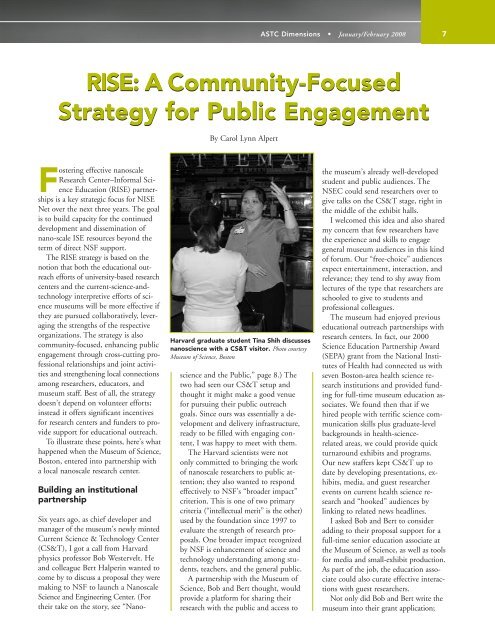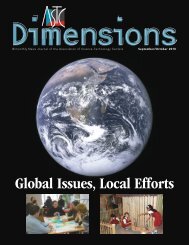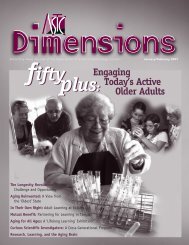Scientists Speak about Nano - Association of Science - Technology ...
Scientists Speak about Nano - Association of Science - Technology ...
Scientists Speak about Nano - Association of Science - Technology ...
Create successful ePaper yourself
Turn your PDF publications into a flip-book with our unique Google optimized e-Paper software.
By Carol Lynn Alpert<br />
ASTC Dimensions • January/February 2008 7<br />
RISE: A Community-Focused<br />
Strategy for Public Engagement<br />
Fostering effective nanoscale<br />
Research Center–Informal <strong>Science</strong><br />
Education (RISE) partnerships<br />
is a key strategic focus for NISE<br />
Net over the next three years. The goal<br />
is to build capacity for the continued<br />
development and dissemination <strong>of</strong><br />
nano-scale ISE resources beyond the<br />
term <strong>of</strong> direct NSF support.<br />
The RISE strategy is based on the<br />
notion that both the educational outreach<br />
efforts <strong>of</strong> university-based research<br />
centers and the current-science-andtechnology<br />
interpretive efforts <strong>of</strong> science<br />
museums will be more effective if<br />
they are pursued collaboratively, leveraging<br />
the strengths <strong>of</strong> the respective<br />
organizations. The strategy is also<br />
community-focused, enhancing public<br />
engagement through cross-cutting pr<strong>of</strong>essional<br />
relationships and joint activities<br />
and strengthening local connections<br />
among researchers, educators, and<br />
museum staff. Best <strong>of</strong> all, the strategy<br />
doesn’t depend on volunteer efforts;<br />
instead it <strong>of</strong>fers significant incentives<br />
for research centers and funders to provide<br />
support for educational outreach.<br />
To illustrate these points, here’s what<br />
happened when the Museum <strong>of</strong> <strong>Science</strong>,<br />
Boston, entered into partnership with<br />
a local nanoscale research center.<br />
Building an institutional<br />
partnership<br />
Six years ago, as chief developer and<br />
manager <strong>of</strong> the museum’s newly minted<br />
Current <strong>Science</strong> & <strong>Technology</strong> Center<br />
(CS&T), I got a call from Harvard<br />
physics pr<strong>of</strong>essor Bob Westervelt. He<br />
and colleague Bert Halperin wanted to<br />
come by to discuss a proposal they were<br />
making to NSF to launch a <strong>Nano</strong>scale<br />
<strong>Science</strong> and Engineering Center. (For<br />
their take on the story, see “<strong>Nano</strong>-<br />
Harvard graduate student Tina Shih discusses<br />
nanoscience with a CS&T visitor. Photo courtesy<br />
Museum <strong>of</strong> <strong>Science</strong>, Boston<br />
science and the Public,” page 8.) The<br />
two had seen our CS&T setup and<br />
thought it might make a good venue<br />
for pursuing their public outreach<br />
goals. Since ours was essentially a development<br />
and delivery infrastructure,<br />
ready to be filled with engaging content,<br />
I was happy to meet with them.<br />
The Harvard scientists were not<br />
only committed to bringing the work<br />
<strong>of</strong> nanoscale researchers to public attention;<br />
they also wanted to respond<br />
effectively to NSF’s “broader impact”<br />
criterion. This is one <strong>of</strong> two primary<br />
criteria (“intellectual merit” is the other)<br />
used by the foundation since 1997 to<br />
evaluate the strength <strong>of</strong> research proposals.<br />
One broader impact recognized<br />
by NSF is enhancement <strong>of</strong> science and<br />
technology understanding among students,<br />
teachers, and the general public.<br />
A partnership with the Museum <strong>of</strong><br />
<strong>Science</strong>, Bob and Bert thought, would<br />
provide a platform for sharing their<br />
research with the public and access to<br />
the museum’s already well-developed<br />
student and public audiences. The<br />
NSEC could send researchers over to<br />
give talks on the CS&T stage, right in<br />
the middle <strong>of</strong> the exhibit halls.<br />
I welcomed this idea and also shared<br />
my concern that few researchers have<br />
the experience and skills to engage<br />
general museum audiences in this kind<br />
<strong>of</strong> forum. Our “free-choice” audiences<br />
expect entertainment, interaction, and<br />
relevance; they tend to shy away from<br />
lectures <strong>of</strong> the type that researchers are<br />
schooled to give to students and<br />
pr<strong>of</strong>essional colleagues.<br />
The museum had enjoyed previous<br />
educational outreach partnerships with<br />
research centers. In fact, our 2000<br />
<strong>Science</strong> Education Partnership Award<br />
(SEPA) grant from the National Institutes<br />
<strong>of</strong> Health had connected us with<br />
seven Boston-area health science research<br />
institutions and provided funding<br />
for full-time museum education associates.<br />
We found then that if we<br />
hired people with terrific science communication<br />
skills plus graduate-level<br />
backgrounds in health-sciencerelated<br />
areas, we could provide quick<br />
turnaround exhibits and programs.<br />
Our new staffers kept CS&T up to<br />
date by developing presentations, exhibits,<br />
media, and guest researcher<br />
events on current health science research<br />
and “hooked” audiences by<br />
linking to related news headlines.<br />
I asked Bob and Bert to consider<br />
adding to their proposal support for a<br />
full-time senior education associate at<br />
the Museum <strong>of</strong> <strong>Science</strong>, as well as tools<br />
for media and small-exhibit production.<br />
As part <strong>of</strong> the job, the education associate<br />
could also curate effective interactions<br />
with guest researchers.<br />
Not only did Bob and Bert write the<br />
museum into their grant application;





